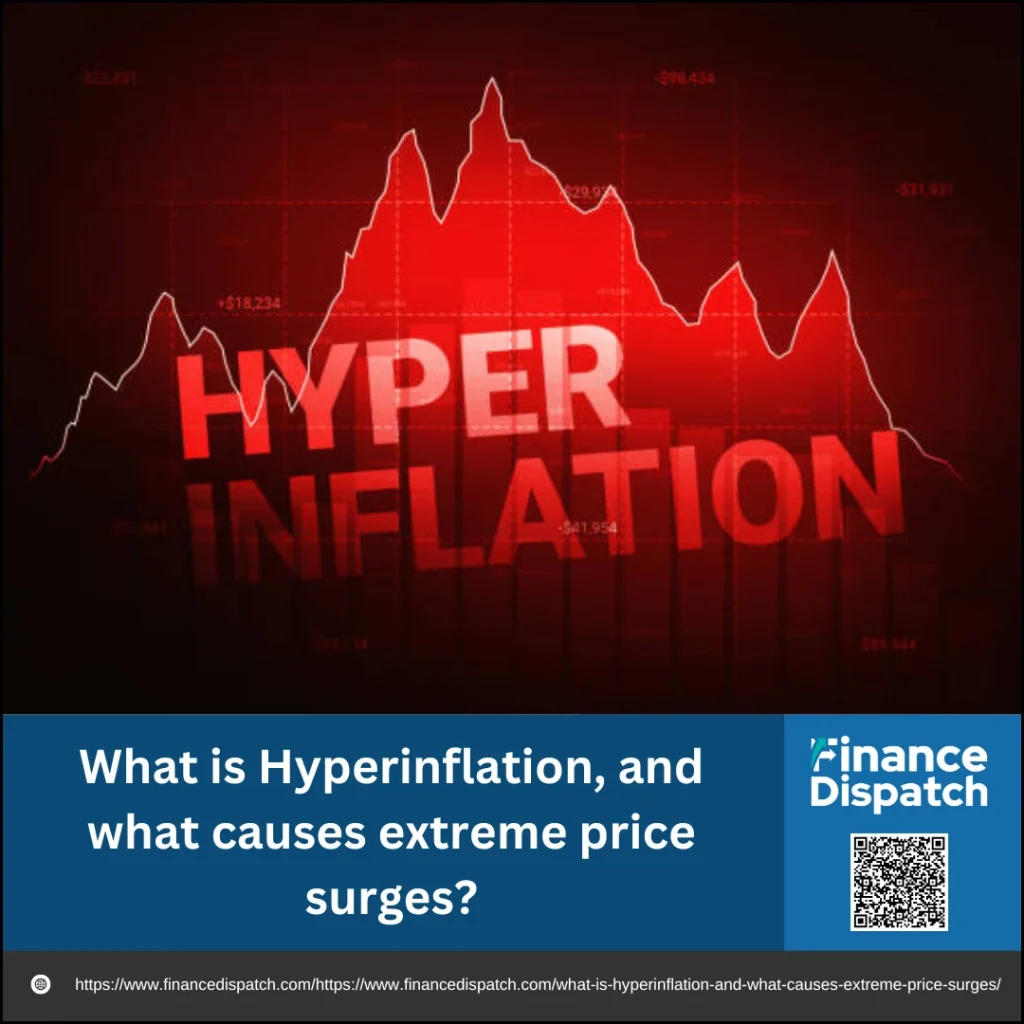Imagine walking into a store and finding that the price of basic groceries has doubled in just a few days. This alarming scenario is not just theoretical — it has occurred in many countries throughout history during periods of hyperinflation. Hyperinflation refers to an extremely rapid and uncontrolled rise in prices, typically where inflation exceeds 50% in a single month. While rare, its impact on everyday life and national economies can be devastating. But extreme price surges are not always due to hyperinflation alone. They can also result from sudden disruptions in supply chains, natural disasters, wars, or shifts in government policies. In this article, we’ll explore what hyperinflation really means, what causes these dramatic spikes in prices, and why understanding them is crucial for protecting your financial well-being.
What is Hyperinflation?
Hyperinflation is an economic phenomenon where the prices of goods and services rise at an extremely rapid and out-of-control rate, typically more than 50% in a single month. Unlike normal inflation, which occurs gradually over time, hyperinflation happens so quickly that the value of money erodes almost daily, making it difficult for people to afford basic necessities. During hyperinflation, the purchasing power of a country’s currency collapses, often forcing citizens to rely on bartering or foreign currencies just to survive. This extreme inflation usually stems from underlying economic problems, such as excessive money printing, political instability, or a collapse in production and supply chains. Although hyperinflation is rare in stable economies, when it does occur, it can lead to widespread poverty, financial system breakdowns, and severe societal unrest.
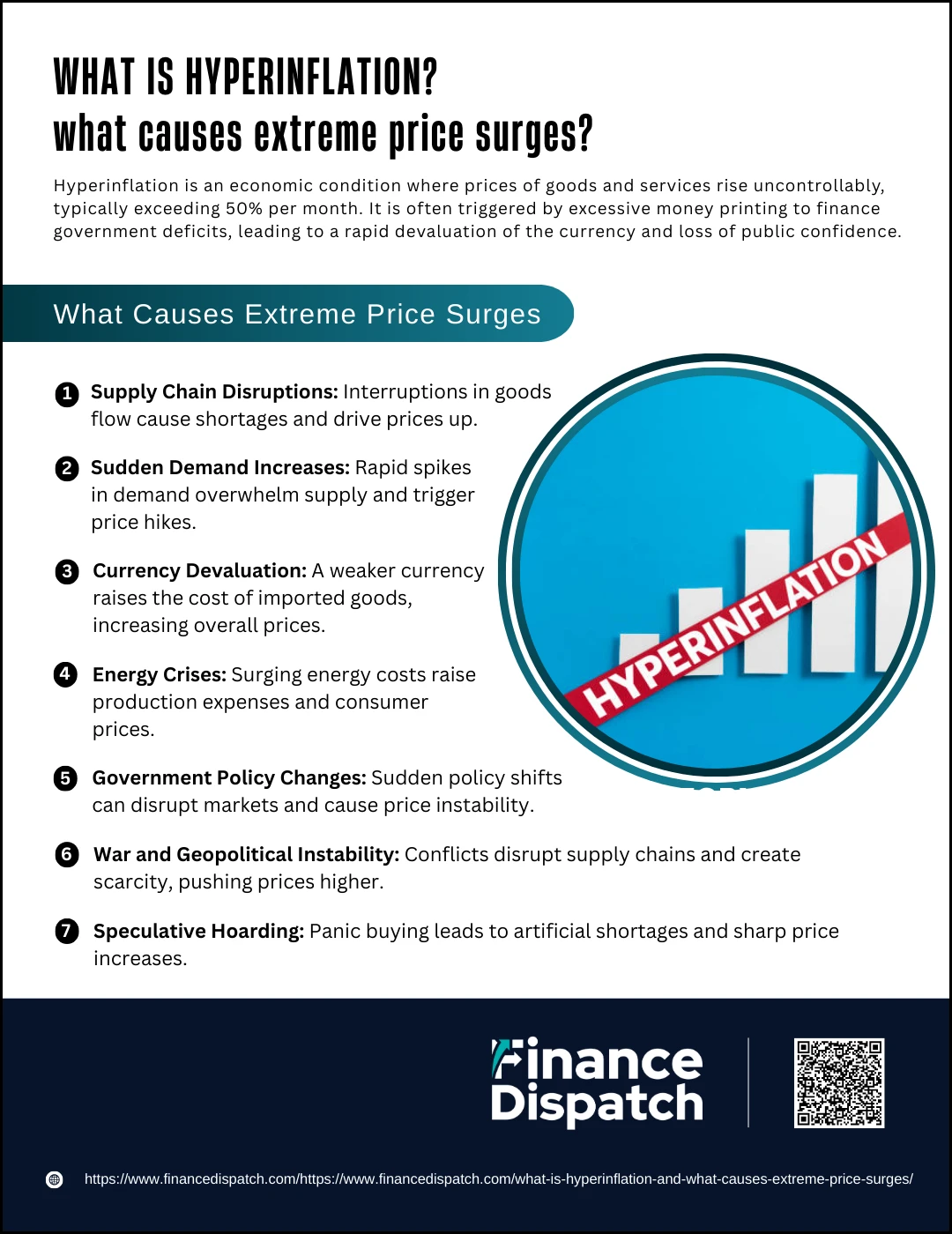 What Causes Extreme Price Surges?
What Causes Extreme Price Surges?
Extreme price surges occur when the cost of goods and services rises rapidly within a short period, causing significant strain on consumers and businesses alike. These surges can happen even in relatively stable economies and are often triggered by unexpected shocks that disrupt normal supply and demand balances. Understanding the root causes helps to recognize early warning signs and prepare for potential financial impacts.
Here are some of the major causes of extreme price surges explained in detail:
1. Supply Chain Disruptions
When the flow of goods is interrupted — due to natural disasters, pandemics, port closures, or labor shortages — businesses struggle to restock products. With fewer goods available, prices climb as competition for limited inventory intensifies. For example, global shipping delays during the COVID-19 pandemic caused shortages of essential items, pushing their prices higher.
2. Sudden Demand Increases
A rapid surge in demand can overwhelm available supply, leading to steep price hikes. This often happens during economic recoveries, holiday seasons, or after policy changes that encourage more spending. If manufacturers and retailers cannot quickly scale up production to meet the demand, prices will naturally rise.
3. Currency Devaluation
When a country’s currency weakens against foreign currencies, the cost of imported goods rises sharply. Since many economies rely on imports for raw materials, fuel, and food, a weaker domestic currency makes everyday products more expensive, leading to widespread price surges.
4. Energy Crises
Energy is a foundation of modern economies — it powers factories, transportation, and households. A sharp increase in oil, gas, or electricity prices raises production costs across industries. Companies often pass these higher costs onto consumers, causing prices of everything from groceries to airline tickets to surge dramatically.
5. Government Policy Changes
Policy decisions can sometimes unintentionally trigger price surges. Removing subsidies on basic goods, imposing tariffs on imports, or injecting large amounts of stimulus money into the economy can disrupt price stability. While such actions may aim to stabilize the economy, they often cause short-term price shocks if not managed carefully.
6. War and Geopolitical Instability
Conflicts can destroy infrastructure, block trade routes, and create uncertainty in global markets. During wars, countries may face shortages of critical goods like food, fuel, and medical supplies. This scarcity, combined with increased uncertainty, drives prices upward as people and businesses scramble to secure essential resources.
7. Speculative Hoarding
Fear of future shortages can lead consumers and businesses to buy excessive amounts of goods, even when supply would have been sufficient under normal purchasing patterns. This panic buying creates artificial shortages, worsening the supply-demand gap and causing even steeper price increases, especially for essential goods like food, fuel, and medicine.
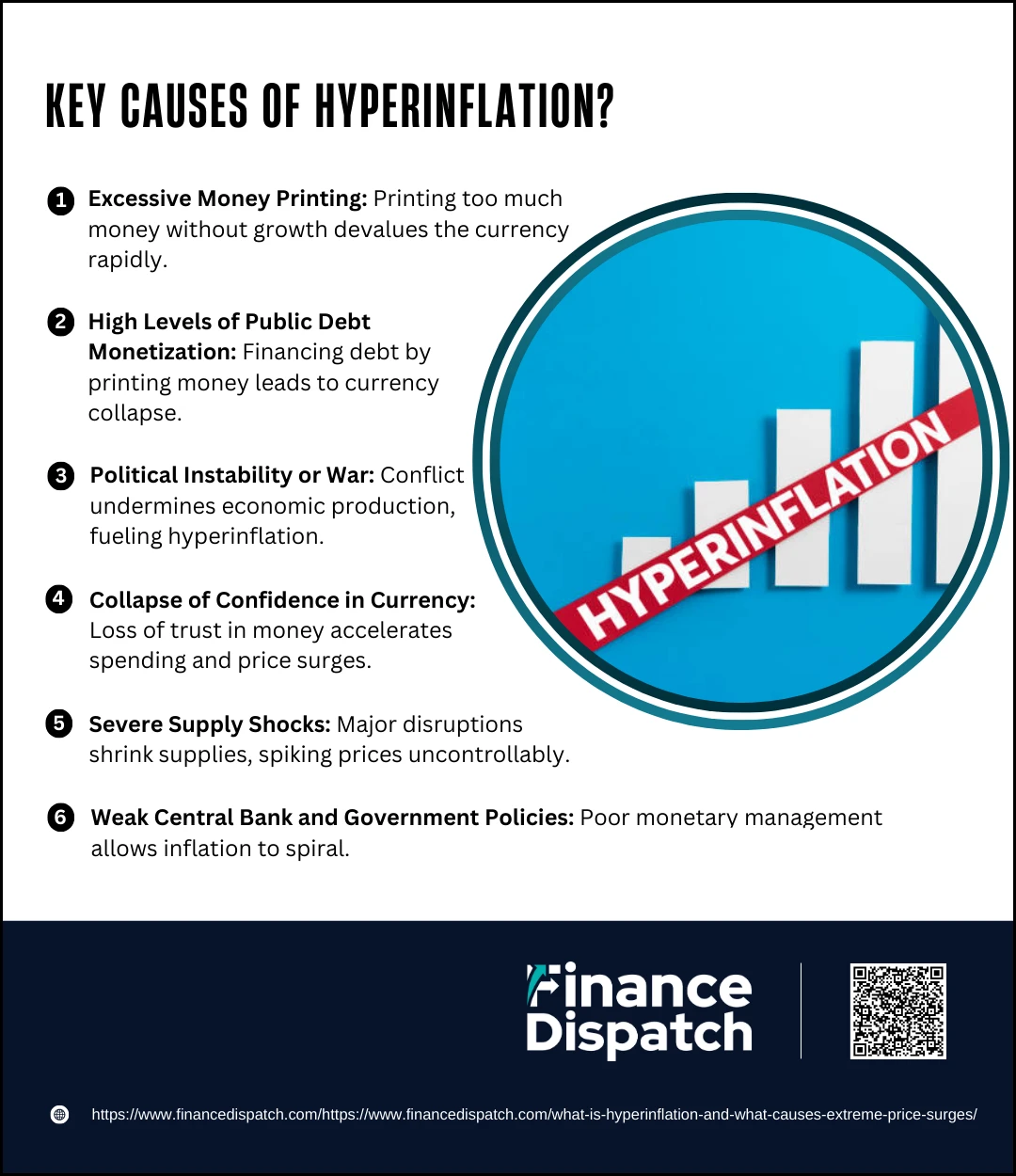 Key Causes of Hyperinflation
Key Causes of Hyperinflation
Hyperinflation doesn’t occur randomly — it is often the result of deep-rooted economic problems and policy failures. While regular inflation can be a normal part of economic growth, hyperinflation signals that something much more serious has gone wrong. Understanding the primary causes of hyperinflation helps reveal how countries spiral into uncontrollable price increases and economic collapse.
Here are the key causes of hyperinflation explained in detail:
1. Excessive Money Printing
When governments or central banks print large amounts of money without a matching growth in economic output, the value of the currency drops dramatically. With too much money chasing too few goods, prices rise rapidly. This vicious cycle worsens as authorities continue printing more money to cover growing expenses, further accelerating inflation.
2. High Levels of Public Debt Monetization
When a country accumulates massive debt and cannot raise enough money through taxes or borrowing, it may resort to printing money to finance its obligations. This process, known as debt monetization, erodes confidence in the currency and fuels hyperinflation as people rush to spend their money before it loses even more value.
3. Political Instability or War
Wars, revolutions, and political chaos can cripple a country’s production and trade systems. Governments struggling with conflict may print more money to fund military expenses or social programs, leading to runaway inflation. At the same time, economic instability discourages investment and production, creating supply shortages that drive prices even higher.
4. Collapse of Confidence in Currency
Hyperinflation often occurs when citizens and businesses lose faith in their national currency. When people believe that money will lose its value rapidly, they spend it as quickly as possible or switch to alternative currencies or barter systems. This loss of trust accelerates price increases and destabilizes the economy even further.
5. Severe Supply Shocks
Events like natural disasters, wars, or pandemics can severely disrupt the supply of essential goods such as food, energy, and medicine. When supplies shrink dramatically while demand remains high, prices can skyrocket. In such cases, even without excessive money printing, inflation can reach uncontrollable levels, especially if government responses worsen the crisis.
6. Weak Central Bank and Government Policies
Countries with poorly managed monetary systems or corrupt governments are especially vulnerable to hyperinflation. Without strong, credible leadership to implement sound fiscal and monetary policies, inflationary pressures can spiral out of control. Attempts to impose price controls or subsidies without addressing root causes often backfire, leading to shortages and black-market pricing.
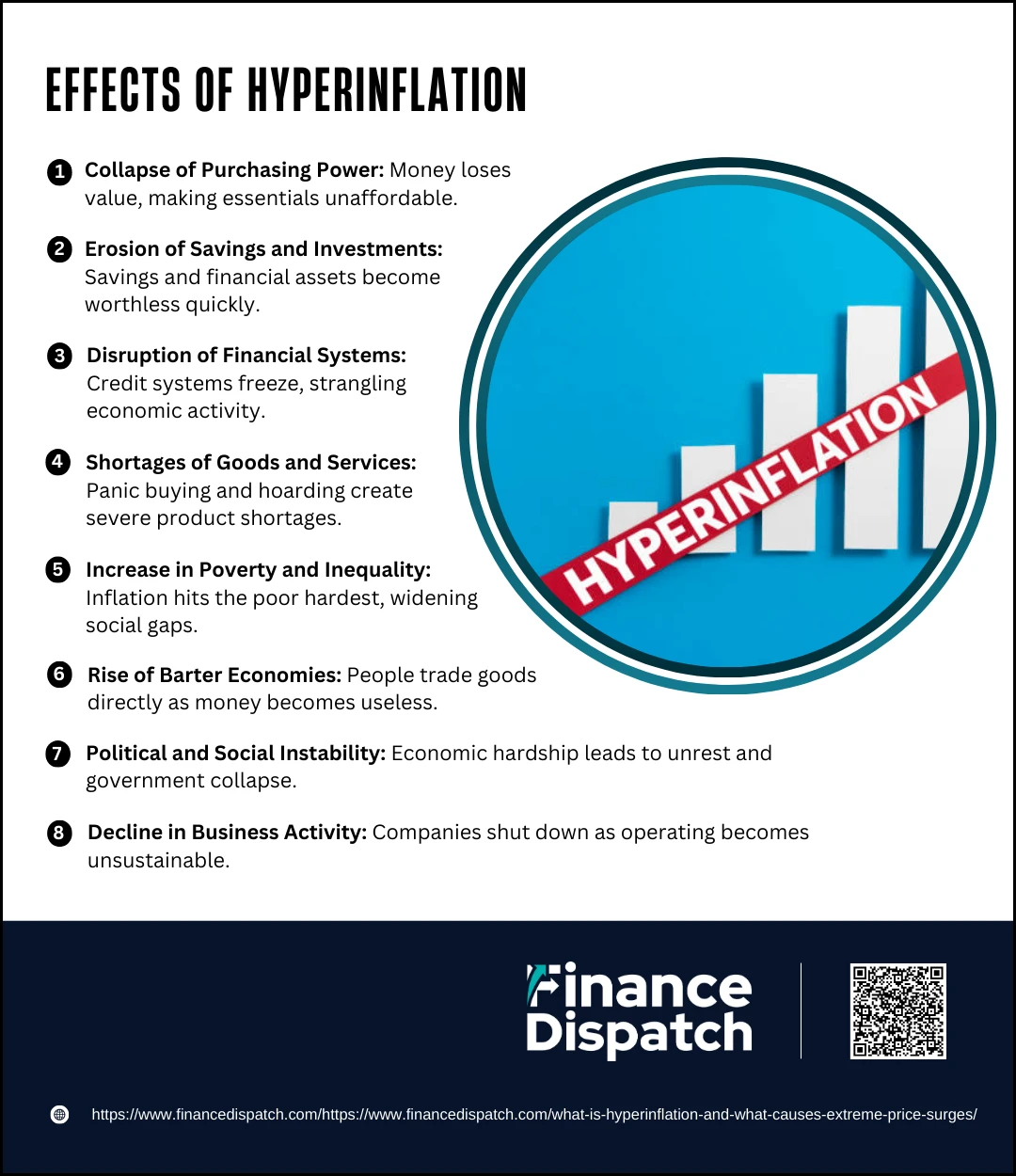 Effects of Hyperinflation
Effects of Hyperinflation
Hyperinflation is more than just a rapid rise in prices — it has devastating impacts on every part of society. It weakens economies, destabilizes governments, and severely affects the daily lives of ordinary people. Once hyperinflation sets in, it creates a cycle of economic collapse that can take years, or even decades, to recover from. Understanding these effects helps highlight why preventing hyperinflation is so critical.
Here are the major effects of hyperinflation:
1. Collapse of Purchasing Power
As prices rise uncontrollably, the real value of money drops sharply. People find that their salaries, savings, and pensions cannot buy as much as they used to, making everyday essentials like food, clothing, and shelter increasingly unaffordable.
2. Erosion of Savings and Investments
Hyperinflation destroys the value of savings and financial investments. Money saved over years can become worthless within months. People lose confidence in banks and may withdraw their funds or shift assets into physical goods, gold, or foreign currencies.
3. Disruption of Financial Systems
Banks and lenders suffer as loans lose their real value and borrowers are either unable or unwilling to repay debts. Credit markets freeze, making it difficult for businesses and consumers to borrow money, further strangling economic activity.
4. Shortages of Goods and Services
Hyperinflation often leads to panic buying and hoarding, causing severe shortages of basic necessities. Producers may stop selling goods if they expect prices to rise dramatically the next day, leading to empty store shelves and a flourishing black market.
5. Increase in Poverty and Inequality
While the wealthy might find ways to protect their assets, lower- and middle-income groups suffer the most. As basic goods become unaffordable, poverty rates surge, deepening social divisions and worsening inequality.
6. Rise of Barter Economies
When currency becomes almost worthless, people often revert to bartering — exchanging goods and services directly without using money. This makes trade far less efficient and creates additional hardships in daily life.
7. Political and Social Instability
Widespread economic hardship often leads to protests, civil unrest, and even revolutions. Governments may fall, and political systems can collapse under the pressure of public anger and frustration caused by hyperinflation.
8. Decline in Business Activity
Businesses struggle to operate when costs rise unpredictably and consumers cannot afford their products. Planning becomes impossible, leading many companies to shut down or drastically scale back, which worsens unemployment and economic decline.
Historical Examples of Hyperinflation
Throughout history, several countries have experienced hyperinflation, each with devastating consequences for their economies and societies. Although the specific causes varied — from war to political mismanagement — the end results were often the same: a collapse in currency value, widespread poverty, and the need for radical economic reforms. Looking at real-world examples helps illustrate how quickly and severely hyperinflation can spiral out of control.
Here’s a table highlighting some of the most notable cases of hyperinflation:
| Country | Period | Main Causes | Peak Monthly Inflation Rate |
| Germany | 1921–1923 | War reparations, excessive money printing | ~29,500% |
| Zimbabwe | 2007–2008 | Land reforms, economic mismanagement | ~79.6 billion % |
| Hungary | 1945–1946 | Post-war devastation, currency collapse | ~41.9 quadrillion % |
| Yugoslavia | 1992–1994 | Political instability, war, government corruption | ~313,000,000% |
| Venezuela | 2016–2020 | Oil crisis, political mismanagement, sanctions | ~10,000,000%+ |
| Greece | 1944–1946 | WWII occupation, war expenses | ~13,800% |
| Nicaragua | 1988–1990 | Political instability, overspending | ~33,500% |
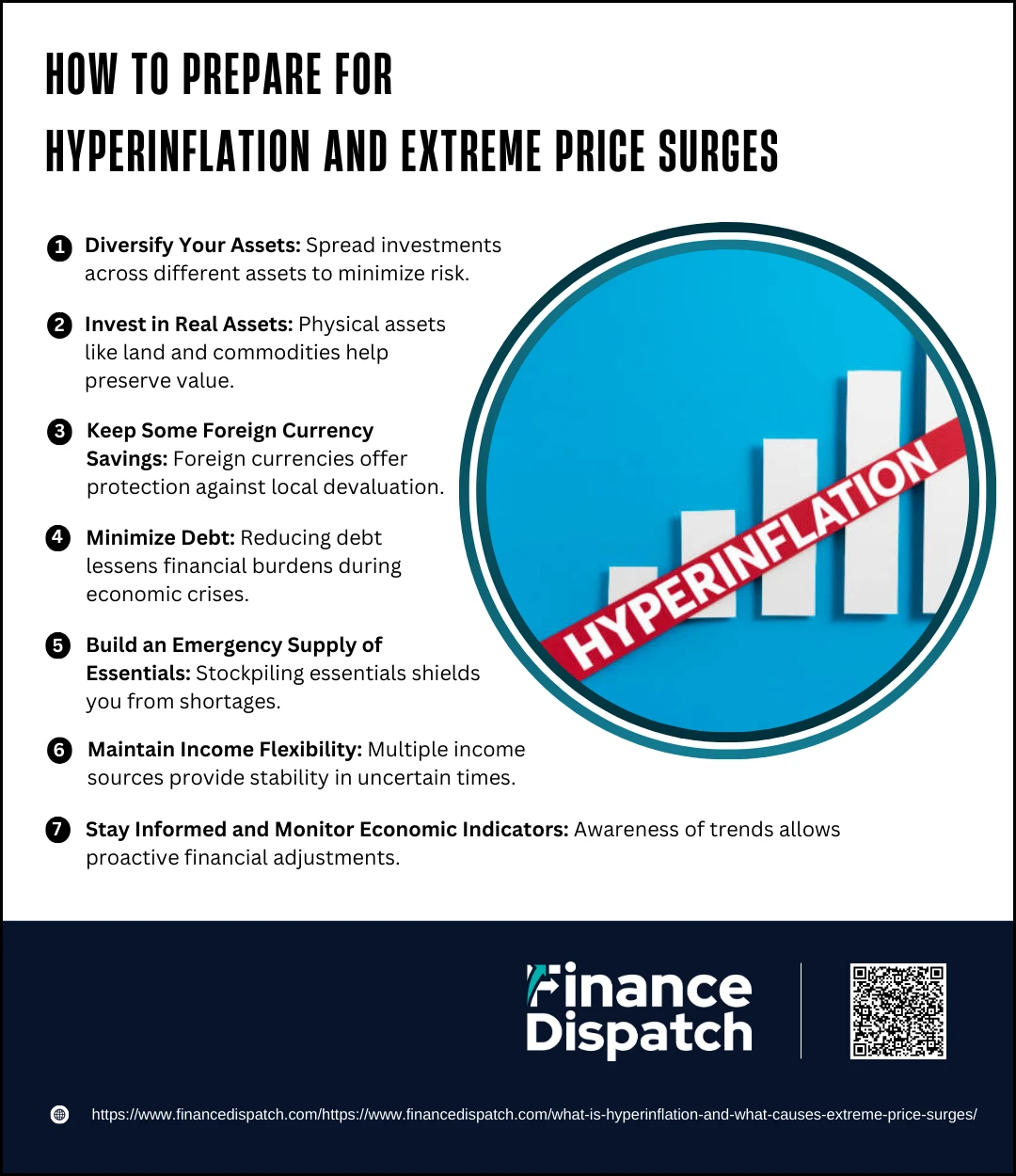 How to Prepare for Hyperinflation and Extreme Price Surges
How to Prepare for Hyperinflation and Extreme Price Surges
Although hyperinflation and extreme price surges are rare in stable economies, they can happen unexpectedly due to global crises, political instability, or natural disasters. Preparing in advance can help protect your financial health, maintain access to essentials, and reduce stress during turbulent times. A few smart steps taken early can make a significant difference if economic conditions worsen.
Here are practical ways to prepare:
1. Diversify Your Assets
Avoid putting all your wealth in cash or a single investment. Spread your assets across real estate, precious metals (like gold and silver), stocks, inflation-protected bonds (such as TIPS), and other commodities. Diversification helps reduce the risk of losing everything if one asset class collapses.
2. Invest in Real Assets
Physical assets like land, property, and commodities often retain value or even appreciate during times of inflation. Owning tangible assets provides a hedge against currency devaluation and ensures you have something of value even if cash loses purchasing power.
3. Keep Some Foreign Currency Savings
Holding a portion of your savings in strong foreign currencies, such as the U.S. dollar, Swiss franc, or euro, can protect you if your national currency weakens significantly. Access to stable currencies can also help you buy imported goods when local money loses value.
4. Minimize Debt
In hyperinflationary periods, interest rates can skyrocket, making debt repayment extremely burdensome. Focus on paying off high-interest loans and avoid taking on new debts whenever possible to reduce financial strain if prices surge.
5. Build an Emergency Supply of Essentials
Stockpile non-perishable food, clean water, medicine, hygiene products, and other essential supplies. Having a reserve allows you to avoid panic buying and inflated prices if shortages occur during economic turmoil.
6. Maintain Income Flexibility
Consider building multiple streams of income or skills that are always in demand (like healthcare, repair work, or agriculture). If traditional employment becomes unstable, alternative income sources can provide a critical safety net.
7. Stay Informed and Monitor Economic Indicators
Pay attention to inflation trends, central bank policies, and major global events. Early awareness can give you time to adjust your financial strategy before a crisis deepens. Trusted financial news sources and economic reports are valuable tools for staying ahead.
Can Hyperinflation Happen in Developed Economies?
While hyperinflation is often associated with unstable or war-torn countries, it is natural to wonder whether developed economies like the United States, Germany, or Japan could face the same fate. In reality, hyperinflation in developed nations is extremely rare due to strong central banks, stable political systems, and sound fiscal policies. Institutions like the Federal Reserve closely monitor inflation indicators and can implement corrective measures such as adjusting interest rates, tightening monetary supply, or raising reserve requirements for banks. Although developed economies can experience high inflation during crises, like after wars or financial shocks, a full-scale hyperinflation event typically requires prolonged economic mismanagement, political collapse, or external disasters — factors that are much less common in mature, resilient economies. Nevertheless, maintaining vigilance and responsible governance remains essential to avoid the risks of runaway inflation.
Conclusion
Hyperinflation and extreme price surges have left deep scars on the economies and societies that experienced them, serving as powerful reminders of how fragile financial systems can be. While hyperinflation is rare in stable countries, the conditions that lead to extreme inflation — such as excessive money printing, political instability, and supply disruptions — can emerge unexpectedly. By studying historical examples and understanding the early warning signs, individuals and governments alike can take proactive steps to protect economic stability. Staying informed, diversifying assets, reducing debt, and preparing for uncertainty are critical strategies for safeguarding financial security in a rapidly changing world. Vigilance today can help prevent crises tomorrow.



